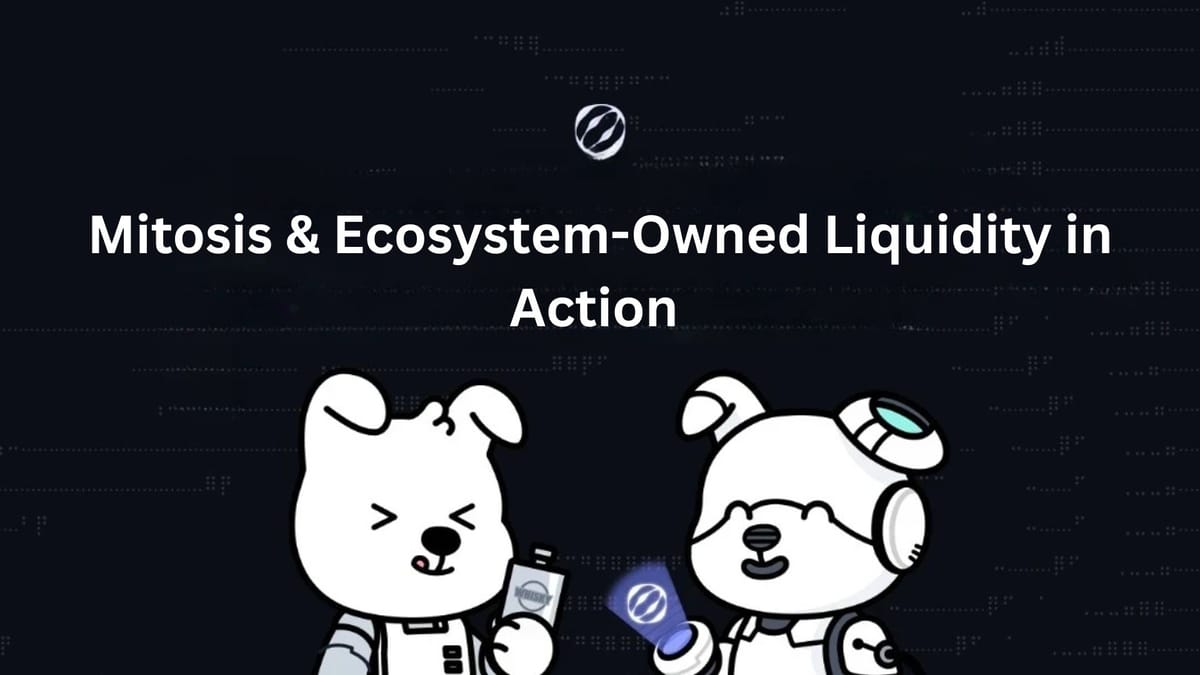Mitosis & Ecosystem-Owned Liquidity in Action

Introduction
Liquidity is the backbone of decentralized finance (DeFi), but traditional liquidity models have proven to be unsustainable. Many protocols rely on liquidity mining or rent-seeking liquidity providers (LPs) who withdraw funds as soon as rewards dry up. This instability creates inefficiencies and hinders long-term growth.
Mitosis introduces Ecosystem-Owned Liquidity (EOL)—a liquidity model designed to give protocols ownership over their liquidity, ensuring sustainability, efficiency, and long-term capital retention.
In this article, we’ll break down how Mitosis operates, compare EOL with Protocol-Owned Liquidity (POL), explore its real-world impact, and examine its role in the future of DeFi.
1. How Mitosis Operates: A Breakdown of Its Liquidity Management Approach
Mitosis is a modular liquidity layer designed for multi-chain DeFi. It provides an efficient system where liquidity is pooled, optimized, and owned by the ecosystem, reducing dependence on mercenary capital. Here’s how it works:
- Multi-Chain Liquidity Aggregation
- Mitosis unifies liquidity across multiple chains, allowing assets to move seamlessly.
- LPs no longer need to manually bridge assets or rely on inefficient cross-chain solutions.
- Ecosystem-Owned Liquidity (EOL) Mechanism
- Instead of rewarding LPs with unsustainable incentives, Mitosis enables protocols to own and manage liquidity directly.
- Treasury funds are allocated to liquidity pools, ensuring long-term stability without excessive token emissions.
- Governance-Driven Liquidity Allocation
- Mitosis employs a transparent governance model where liquidity is allocated based on clearly defined metrics.
- This prevents manipulation by large stakeholders and ensures fair distribution of liquidity resources.
- Automated Liquidity Optimization
- Smart contracts continuously adjust liquidity based on market conditions.
- This ensures capital efficiency, low slippage, and deep liquidity across all chains.
2. EOL vs. POL: Why Ecosystem Ownership Is Superior
Protocol-Owned Liquidity (POL) was introduced as a response to mercenary capital, where protocols acquire their own liquidity (e.g., OlympusDAO’s bonding model). While POL improves sustainability, it often results in inefficient capital allocation and fragmented liquidity.
Ecosystem-Owned Liquidity (EOL), on the other hand, takes POL a step further by making liquidity ownership collective and multi-chain optimized.

Why EOL Wins:
- Greater Liquidity Efficiency: Instead of protocols hoarding liquidity, EOL ensures that assets flow to where they’re needed most.
- Multi-Chain Advantage: Unlike POL, which is often siloed, EOL enables liquidity to move freely across networks.
- Fairer Market Dynamics: EOL removes whale dominance and ensures liquidity is managed based on transparent governance.
3. Real-World Impact: How Mitosis Can Reshape DeFi Liquidity Models
Mitosis and EOL have the potential to fundamentally change how liquidity is managed in DeFi. Here’s what this means in practice:
- Protocols Reduce Dependence on LPs
- Instead of chasing yield farmers, protocols can rely on self-sustaining liquidity.
- This removes the need for high emissions that dilute token value.
- More Efficient Capital Deployment
- EOL ensures that liquidity is allocated based on real demand rather than speculative farming.
- This leads to lower slippage, better pricing, and more efficient trading.
- Cross-Chain Liquidity Becomes Seamless
- With EOL, liquidity can be dynamically adjusted across multiple chains, preventing fragmentation.
- This improves user experience, transaction efficiency, and capital utilization.
- Protocols Can Focus on Innovation
- Instead of constantly worrying about liquidity retention, teams can focus on building.
- Long-term liquidity stability fosters better products, stronger communities, and sustainable growth.
4. Future Outlook: The Role of Mitosis in a Multi-Chain DeFi World
As DeFi moves toward a multi-chain future, liquidity must be flexible, sustainable, and efficiently allocated. Mitosis is at the forefront of this transition, providing:
- A scalable liquidity layer that works across all major chains.
- A governance-driven approach that ensures fair and transparent liquidity distribution.
- A long-term sustainability model that replaces short-term incentives with ecosystem-owned liquidity.
In the next phase of DeFi, protocols that embrace EOL will have a massive competitive advantage. Instead of struggling with liquidity retention, they’ll be part of a unified liquidity network that ensures efficiency, stability, and long-term growth.
Conclusion
Mitosis is redefining liquidity management through Ecosystem-Owned Liquidity (EOL)—a model that eliminates reliance on mercenary LPs, optimizes capital efficiency, and ensures long-term sustainability.
Compared to traditional models like liquidity mining or POL, EOL provides a superior solution for DeFi protocols looking to scale across multiple chains. By implementing multi-chain liquidity aggregation, governance-driven allocation, and automated optimization, Mitosis is setting a new standard for DeFi liquidity.
As the industry matures, EOL will become the backbone of sustainable liquidity management, and Mitosis will lead the charge in enabling protocols to take full control of their liquidity needs.
The future of DeFi liquidity is ecosystem-owned, cross-chain optimized, and protocol-driven—and Mitosis is making it happen.



Comments ()